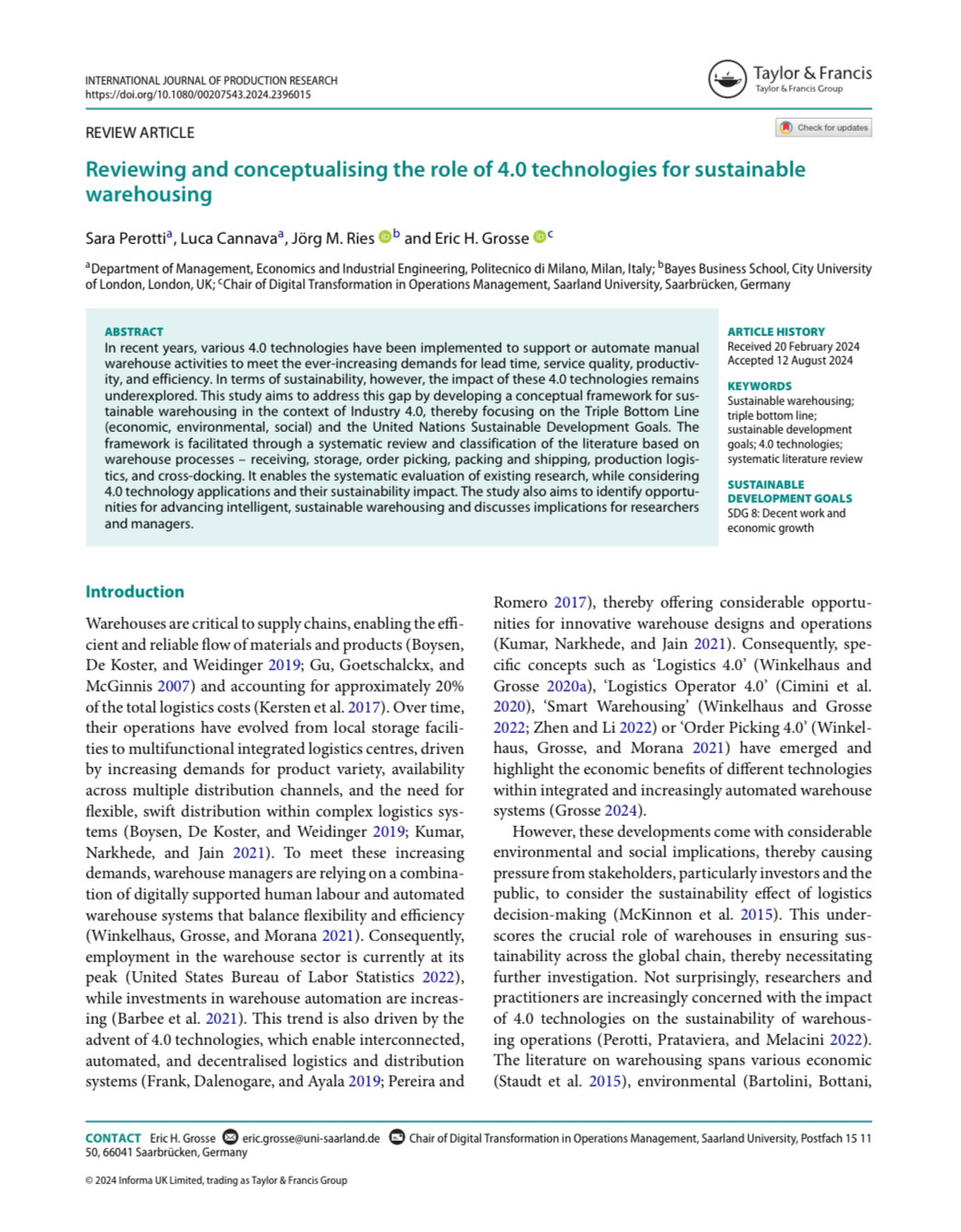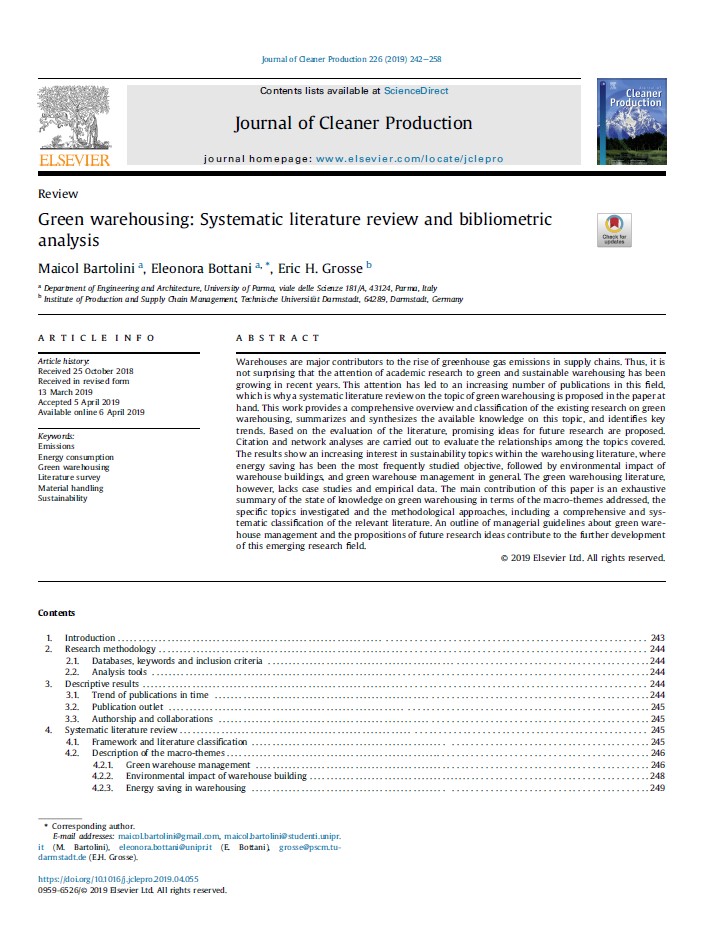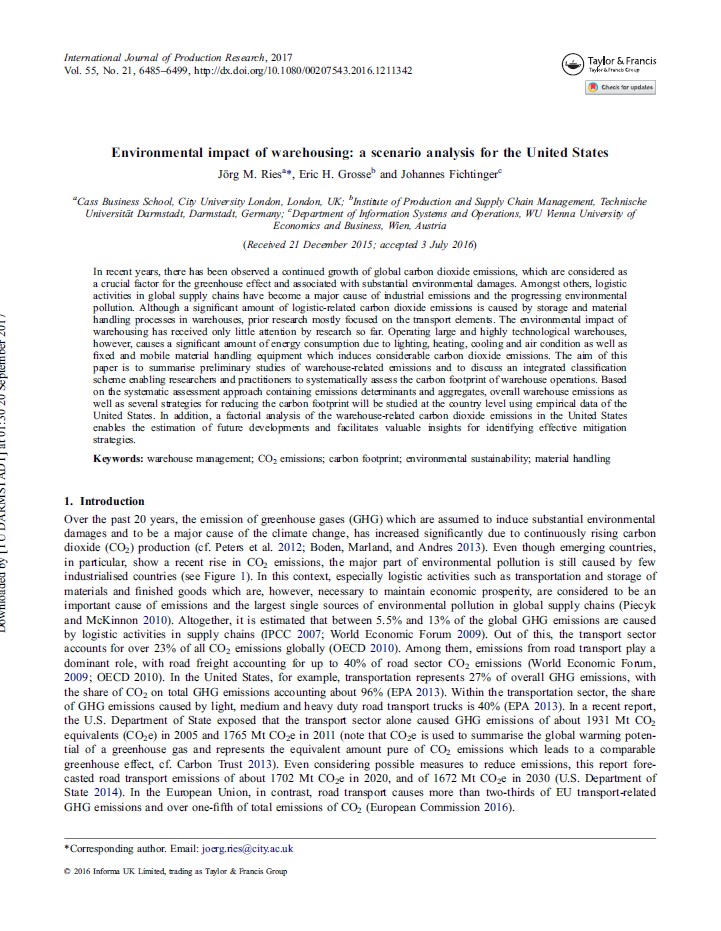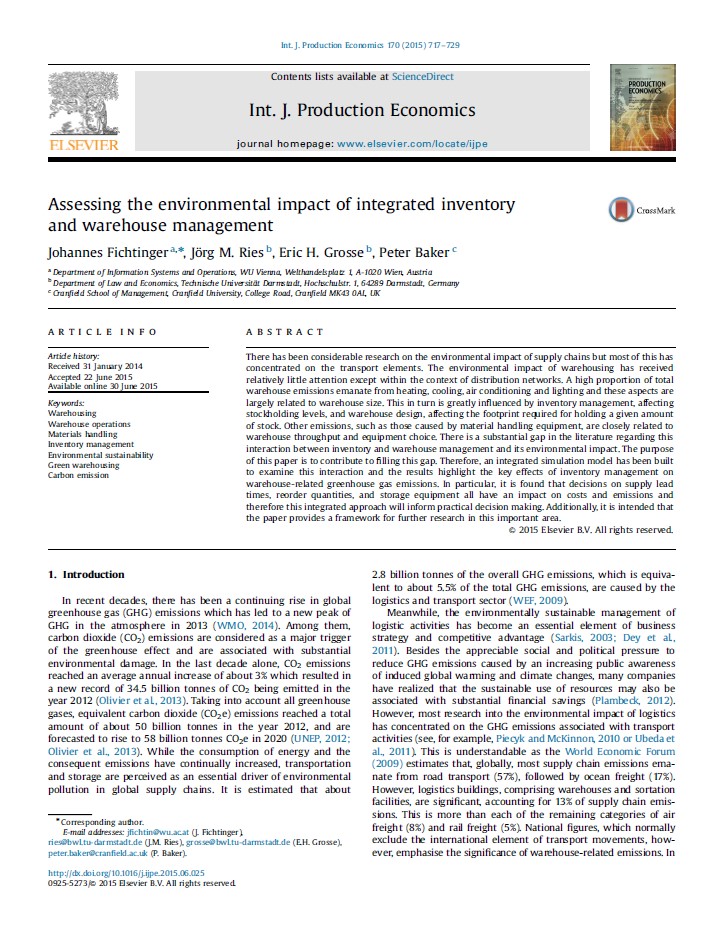Green warehousing
Publikationen

Reviewing and conceptualising the role of 4.0 technologies for sustainable
Perottia, Cannavaa, Ries & Grosse (2024)
International Journal of Production Research
In recent years, various 4.0 technologies have been implemented to support or automate manual warehouse activities to meet the ever-increasing demands for lead time, service quality, productivity, and efficiency. In terms of sustainability, however, the impact of these 4.0 technologies remains underexplored. This study aims to address this gap by developing a conceptual framework for sustainable warehousing in the context of Industry 4.0, thereby focusing on the Triple Bottom Line (economic, environmental, social) and the United Nations Sustainable Development Goals. The framework is facilitated through a systematic review and classification of the literature based on warehouse processes – receiving, storage, order picking, packing and shipping, production logistics, and cross-docking. It enables the systematic evaluation of existing research, while considering 4.0 technology applications and their sustainability impact. The study also aims to identify opportunities for advancing intelligent, sustainable warehousing and discusses implications for researchers and managers.
Green warehousing: Systematic literature review and bibliometric analysis
Bartolini, Bottani & Grosse (2019)
Journal of Cleaner Production 226
Warehouses are major contributors to the rise of greenhouse gas emissions in supply chains. Thus, it is not surprising that the attention of academic research to green and sustainable warehousing has been growing in recent years. This attention has led to an increasing number of publications in this field, which is why a systematic literature review on the topic of green warehousing is proposed in the paper at hand. This work provides a comprehensive overview and classification of the existing research on green warehousing, summarizes and synthesizes the available knowledge on this topic, and identifies key trends. Based on the evaluation of the literature, promising ideas for future research are proposed. Citation and network analyses are carried out to evaluate the relationships among the topics covered. The results show an increasing interest in sustainability topics within the warehousing literature, where energy saving has been the most frequently studied objective, followed by environmental impact of warehouse buildings, and green warehouse management in general. The green warehousing literature, however, lacks case studies and empirical data. The main contribution of this paper is an exhaustive summary of the state of knowledge on green warehousing in terms of the macro-themes addressed, the specific topics investigated and the methodological approaches, including a comprehensive and systematic classification of the relevant literature. An outline of managerial guidelines about green warehouse management and the propositions of future research ideas contribute to the further development of this emerging research field.
Environmental impact of warehousing: a scenario analysis for the United States
Ries, Grosse & Fichtinger (2016)
International Journal of Production Research 55(21)
In recent years, there has been observed a continued growth of global carbon dioxide emissions, which are considered as a crucial factor for the greenhouse effect and associated with substantial environmental damages. Amongst others, logistic activities in global supply chains have become a major cause of industrial emissions and the progressing environmental pollution. Although a significant amount of logistic-related carbon dioxide emissions is caused by storage and material handling processes in warehouses, prior research mostly focused on the transport elements. The environmental impact of warehousing has received only little attention by research so far. Operating large and highly technological warehouses, however, causes a significant amount of energy consumption due to lighting, heating, cooling and air condition as well as fixed and mobile material handling equipment which induces considerable carbon dioxide emissions. The aim of this paper is to summarise preliminary studies of warehouse-related emissions and to discuss an integrated classification scheme enabling researchers and practitioners to systematically assess the carbon footprint of warehouse operations. Based on the systematic assessment approach containing emissions determinants and aggregates, overall warehouse emissions as well as several strategies for reducing the carbon footprint will be studied at the country level using empirical data of the United States. In addition, a factorial analysis of the warehouse-related carbon dioxide emissions in the United States enables the estimation of future developments and facilitates valuable insights for identifying effective mitigation strategies.
Assessing the environmental impact of integrated inventory and warehouse management
Fichtinger, Ries, Grosse & Baker (2015)
International Journal of Production Economics 170
There has been considerable research on the environmental impact of supply chains but most of this has concentrated on the transport elements. The environmental impact of warehousing has received relatively little attention except within the context of distribution networks. A high proportion of total warehouse emissions emanate from heating, cooling, air conditioning and lighting and these aspects are largely related to warehouse size. This in turn is greatly influenced by inventory management, affecting stockholding levels, and warehouse design, affecting the footprint required for holding a given amount of stock. Other emissions, such as those caused by material handling equipment, are closely related to warehouse throughput and equipment choice. There is a substantial gap in the literature regarding this interaction between inventory and warehouse management and its environmental impact. The purpose of this paper is to contribute to filling this gap. Therefore, an integrated simulation model has been built to examine this interaction and the results highlight the key effects of inventory management on warehouse-related greenhouse gas emissions. In particular, it is found that decisions on supply lead times, reorder quantities, and storage equipment all have an impact on costs and emissions and therefore this integrated approach will inform practical decision making. Additionally, it is intended that the paper provides a framework for further research in this important area.




